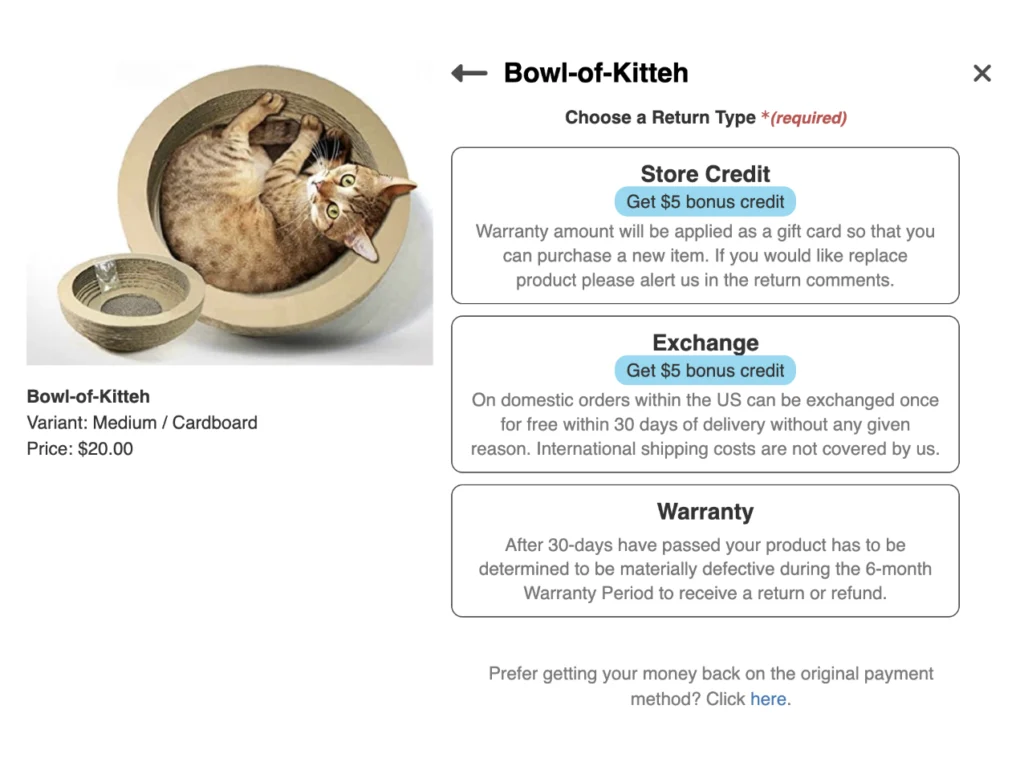The Refund Effect: How Cross-Selling During Product Returns Can Reduce Revenue Loss

Product returns cost merchants a substantial amount of money. In fact, according to a report on the mental accounting of product returns by the University of Toronto, consumers returned 16.5% of all purchases in 2022, costing retailers $816 billion in lost revenue. With merchants always looking for ways to reduce these losses, retention strategies like cross-selling during the product return process, have become an innovative solution for success.
When ecommerce first emerged as a popular method of shopping, returns were seen as an obstacle against profits. Merchants viewed returns as costly, time-consuming, and the furthest thing from being positive for brand perception. However, a lot of that has changed in recent years.
Now, shoppers expect to be able to return products they buy online and are loyal to brands with a customer-friendly returns policy. Returns have become ingrained in ecommerce consumer behavior and as a result, the post-purchase experience has opened up new opportunities for merchants to connect with their customers and deepen their relationships.
In this article, we will delve into the findings of the Toronto report to discuss how cross-selling during the returns process can effectively reduce revenue loss and explore the underlying mechanisms that make it successful.
The Refund Effect: Understanding the Mechanism

Cross-selling during the product RMA process involves encouraging customers to utilize their refund to make additional purchases before completing the return. Merchants on platforms like Shopify have successfully implemented this approach, managing to retain an average of 28.6% of the sales revenue that would have otherwise been lost to product returns.
To comprehend the effectiveness of cross-selling during returns, we must first examine the refund effect. This psychological phenomenon arises from consumers’ realization of the loss of money when purchasing a product and the mental earmarking of that money for spending.
When a customer purchases a product, they have already parted ways with the money they spent. When asking for a refund, that same money is viewed as net income, so spending it on a new product instead of getting a refund feels like getting a new product for free instead of a loss of money.
It’s important to note that the refund effect relies on shoppers approaching the situation with this mindset, which won’t be the case for every single consumer or every single purchase situation.
This effect may not apply when customers anticipate returning an item at the time of purchase (also known as returns fraud).
What Are Some Ways to Reduce Refunds that Support the Refund Effect In-Practice?

It can be impossible to know what a shopper is thinking when they initiate a return. However, that doesn’t negate the power of the refund effect. Regardless of not being able to know which shoppers will succumb to the refund effect, you’re empowered with the knowledge of knowing that some do.
And with that knowledge, you as the merchant have the ability to control the returns process in order to encourage shoppers under the refund effect to turn their return into a sales opportunity by incentivizing exchanges. To further enhance revenue retention during the return process, merchants can implement bonus credits and instant exchanges as complementary strategies.
When doing this, clear communication is key. Merchants should clearly explain these options to customers during the return process, highlighting the benefits and incentives involved. Doing this becomes easier when using returns management software that offers features that help merchants incentivize exchanges with automation, dynamic pricing, and visual deterrence of refund options.
Using automated third-party software for processing returns, managing bonus credits, and instant exchanges, eliminates the time and frustration caused by the manual setup of online store notifications, or training staff members on a laborious process.
The use of returns management software also ensures systems and processes are optimized to facilitate bonus credits and instant exchanges seamlessly. This includes having a well-integrated inventory management and accounting system to handle exchanges, easy training so employees are equipped to handle the process efficiently, and employing appropriate technology solutions to support these strategies.
So, here are different retention strategies that incentivize exchanges and store credit and how they work:
Instant Exchange
Instant exchange or bonus exchange offers customers the option to immediately exchange their returned item for a different product at the time of return. This eliminates the need for customers to go through the traditional return process and wait for a refund before making a new purchase. By streamlining the exchange process, merchants provide convenience and a seamless shopping experience, increasing the likelihood of retaining the sale.
Instant exchanges capitalize on the desire for instant gratification. Customers appreciate the efficiency and simplicity of being able to exchange their items immediately, without any delays or complications. By offering this option, merchants not only retain the revenue from the original sale but also enhance customer satisfaction and loyalty.

Bonus Credits
Bonus credits involve offering customers additional store credits or rewards when they choose to exchange their returned product for another item instead of receiving a refund. By providing this bonus exchange incentive, merchants create a sense of value and exclusivity, encouraging customers to explore alternative products within their stores.
The concept of bonus credits taps into the psychological principle of perceived value. When customers are presented with an opportunity to receive extra store credits, they feel a sense of gain and are more likely to choose an exchange over a refund. This not only retains the initial sale but also potentially leads to additional purchases, as customers are incentivized to spend the bonus credits or risk losing them.
With Bonus Credit, merchants can also enable dynamic pricing will allow them to choose how much additional (dollars or credit) the shopper will receive based on the price of the product being returned.
Store Credit
Store refund credit involves offering customers the option to receive their refund in the form of store credit instead of a cash refund. This approach encourages customers to utilize the refund amount to make future purchases within the same store, rather than taking their business elsewhere. Shoppers will not lose store credit whereas Bonus Credits are set to expire during the bonus exchange workflow.
Providing store refund credit allows merchants to retain the value of the original sale within their ecosystem, preventing the loss of revenue to external competitors. This strategy can be particularly effective when combined with cross-selling opportunities, as it encourages customers to explore additional products and maximize the value of their refund.
De-emphasize Refunds
Merchants can choose to visually deter refunds during the returns process workflow. This technique pushes shoppers towards the option of an exchange or store credit over a cash refund. While the option for a store refund is listed, it’s made less prominent during the returns workflow.
An example of this can be seen within Amazon’s return workflow. Refunds made in the form of Amazon credit are visually prioritized over refunds to the original payment amount.
Strategic Shipping Rules
Through a set of strategic shipping rules, merchants can choose to offer free shipping based on the shopper’s return type. For example, free shipping may be offered for store exchanges or store credit, but not for refunds. It’s important to outline these rules in your return policy and shipping policy so that shoppers are well aware of return shipping rules and exceptions prior to purchase.
Shopify Exchange Credit
When it comes to implementing cross-selling opportunities and enhancing revenue retention during the product return process, Shopify merchants have a valuable tool at their disposal: Shopify Exchange Credit. This feature allows customers to receive their refund as store credit that can be used to make future purchases within the Shopify ecosystem.
Shopify Exchange Credit provides several benefits for both merchants and customers:
- Seamless Integration: Shopify Exchange Credit seamlessly integrates into the Shopify platform, making it easy for merchants to offer store credit as a refund option. The credit is automatically added to the customer’s account, eliminating the need for manual processing and ensuring a smooth experience for both parties.
- Increased Spending within the Shopify Ecosystem: By offering Exchange Credit, Shopify merchants encourage customers to reinvest their refunds back into the Shopify ecosystem. This drives customer loyalty and increases the likelihood of customers making additional purchases from the same store.
- Enhanced Customer Experience: By offering store credit, merchants demonstrate their commitment to customer satisfaction and provide an alternative to cash refunds. This flexibility helps build trust and strengthens the relationship between the customer and the merchant, potentially leading to repeat purchases and long-term loyalty.
Empirical Findings: Testing the Refund Effect on Product Returns

Now that we’ve covered return strategies and tactics for reducing Shopify refunds, let’s circle back to the results for The Refund Effect report.
Through a series of six experiments, researchers have extensively studied the effectiveness of cross-selling during the product return process and examined the underlying principles of the refund effect.
The findings highlight that consumers tend to spend money refunded from product returns more freely than unspent money. Surprisingly, they even exhibit greater spending tendencies with refunded money compared to windfall gains, such as lottery winnings, in both similar and different product categories (e.g., groceries vs. apparel).
However, the impact of The Refund Effect is contingent upon two key factors:
- Consumer expectations regarding product returns at the point of purchase
- The separation of refunded money from other funds
The effect dissipates when consumers anticipate returns or when the refunded amount is commingled with funds in other accounts. These research findings effectively address alternative explanations for consumer behavior, including selection bias, wealth effects, replenished mental accounts, and shopping momentum.
The studies demonstrate that the initial purchase primes participants to shift from a deliberative to an implementation mindset, thereby increasing their inclination to make impulsive purchases during the refund process. The moderating effects of expectations and pooling on The Refund Effect provide compelling evidence in support of the concept.
What This Means for Shopify Merchants
The report’s findings explain that the original perception of online returns is completely wrong. While processed returns incur heavy costs, the act of a customer initiating a return is not a lost sale. In fact, returns have actually opened up a new opportunity for ecommerce merchants to close more deals through cross-selling during the returns process, not less.
While the opportunity presents itself, it’s up to the merchant to do something about it. The extensive research on The Refund Effect suggests that cross-selling during the product return process is an effective revenue retention strategy that can significantly reduce revenue loss for merchants.
Implementing this strategy requires merchants to prompt customers to consider using their refund to purchase alternative products before proceeding with the return. This strategy should be clearly communicated to customers in their return policies, ensuring transparency and minimizing confusion.
When done correctly, cross-selling provides ecommerce merchants with two key benefits:
1) Revenue Retention
By cross-selling during the return process, merchants can retain a significant portion of the sales revenue that would have otherwise been lost to returns. Offering alternative products or suggesting complementary items gives merchants the opportunity to offset the financial impact of returns and minimize revenue loss.
The returns tactics and strategies outlined above leverage the concept of The Refund Effect, where customers psychologically realize the loss of money when making a purchase and are more likely to spend the refund on other products rather than seeking a full refund. By effectively cross-selling, merchants can retain a portion of the original sale and potentially even increase the overall value of the transaction.
2) Increased Customer Engagement
Cross-selling provides an opportunity to engage customers in a meaningful way during the return process. While returns are generally viewed as a negative experience, cross-selling allows merchants to turn it into a positive interaction.
Merchants have the opportunity to delight customers by turning the returns process into a shopping experience. Suggesting alternative products that may meet customers’ needs or preferences allows merchants to demonstrate their commitment to customer satisfaction and personalized service.
This engagement not only helps retain the customer’s interest and loyalty but also presents an opportunity to upsell and increase the customer’s overall purchase and lifetime value. Additionally, the act of cross-selling during returns shows that the merchant values the customer’s business and is invested in providing a seamless shopping experience.
Ecommerce Merchants Who Cross-Sell Win at Returns

Product returns pose a considerable financial burden on merchants, resulting in substantial revenue loss. Cross-selling during the product return process has emerged as a viable solution to mitigate such revenue losses. Returns platforms that offer incentivization tools such as bonus credit, de-emphasizing refunds, and strategic shipping rules are imperative to retain more revenue.
Leveraging The Refund Effect, wherein consumers are more inclined to spend refunded money on additional purchases, merchants can retain a significant portion of the sales revenue that would have otherwise been lost to returns. However, successful implementation of cross-selling during returns necessitates clear communication with customers, ensuring that they understand the strategy and its benefits.
The Refund Effect research provides valuable insights into revenue retention strategies for ecommerce merchants. Incorporating cross-selling and upselling techniques during the product return process allows them to capitalize on the psychological dynamics that influence consumer spending behavior. This approach not only reduces revenue loss but also strengthens customer engagement and fosters loyalty.
As ecommerce merchants continue to seek ways to optimize their operations and maximize profitability, cross-selling during the product return process stands out as a promising strategy. By understanding The Refund Effect and tailoring their approach accordingly, merchants can turn product returns into opportunities for additional sales.
Ready to simplify your returns management?
Schedule a free ecommerce returns audit today!






